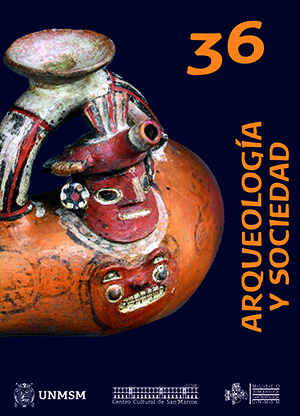Archaeological evidence of the Cupisnique occupation in the El Brujo complex, Chicama valley, north coast of Peru
DOI:
https://doi.org/10.15381/arqueolsoc.2022n36.e22198Keywords:
Formative Period, Cupisnique, Phenomenon El Niño, sacred landscape, coastlineAbstract
The occupation of the Formative in the El Brujo archaeological complex has not yet been fully investigated. The remains of this period are concentrated to the south of the geological platform, between Huaca Paredones to the north and Huaca Prieta to the south. As is known, Huaca Prieta was investigated by Junius Bird in the 1940s and in 2012 Tom Dillehay and his team excavated the same Preceramic mound and other areas, whose radiocarbon dates exceed 14,000 years old. In this article, the results that the El Brujo Archaeological Program obtained in the years 1996 and 2004-2005 are presented with the purpose of understanding the occupation of this period to the south of the archaeological complex. Indeed, it reports the excavation of four human burials in oval pits associated with Cupisnique-style ceramics, located to the south east of the Paredones Mound and, in addition, the findings of elite architecture on the east and north slopes of the Mound are presented. Cupisnique with flat-convex, conical, cylindrical adobe structures and stones. These investigations are compared with Kendall Campbell's findings in 2004 between the Paredones mound and the Cupisnique mound. In short, the presence of a complex occupation is proposed with the presumable presence of a main building (Cupisnique mound) with several phases of occupation, associated to the north with a housing complex where a community of specialists linked to the cult would have settled. the appropriation and consumption of marine products.
Downloads
Published
Issue
Section
License
Copyright (c) 2022 Regulo Franco Jordan, Jeffrey Quilter

This work is licensed under a Creative Commons Attribution 4.0 International License.
THE AUTHORS RETAIN THEIR RIGHTS:
a. The authors retain their trademark and patent rights, and also on any process or procedure described in the article.
b. The authors retain the right to share, copy, distribute, perform and publicly communicate the article published in the Arqueología y Sociedad (for example, place it in an institutional repository or publish it in a book), with an acknowledgment of its initial publication in the Arqueología y Sociedad.
c. The authors retain the right to make a subsequent publication of their work, to use the article or any part of it (for example: a compilation of their works, notes for conferences, thesis, or for a book), provided that they indicate the source. of publication (authors of the work, journal, volume, number and date).






